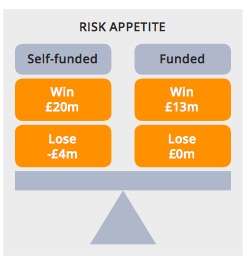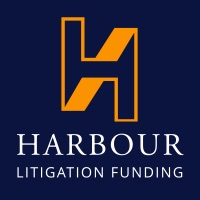11 April, 2018
With disputes emerging as an asset class, it is important that corporates consider the benefits of dispute funding, but also its impact on the financial statements.
The accountant’s angle
Financial Directors (FDs) wishing to use dispute nance can be classi ed as those seeking funding a) by choice or b) by necessity with one constant – disputes are expensive and risky. The majority of FDs are risk adverse and welcome any opportunity to hedge risks, whilst retaining the potential to create an asset. Whether a claimant has access to cash or not, dispute funding should be considered when seeking to unlock value from a dispute portfolio.
When assessing a legal dispute an FD considers: i) do we have the cash ow to risk on legal costs, ii) what is the nancial impact if we lose and iii) what is the ‘opportunity cost’ of using this cash i.e. could it be better deployed for capital expenditure, growth or investment opportunities?
An obvious benefit of funding is the removal of obligations for legal fees and adverse costs – without a negative income statement or cash ow impact – with the added advantage that the dispute nance and contingent liabilities remain completely off-balance sheet. That said, the funder requires a return on their investment which means the claimant will not recover the total value of the damages, should they win.
One limitation to a corporate’s dispute portfolio strategy is cash. Once that constraint is removed, it is arguable that claims that otherwise would not be brought, can be pursued. By expanding a corporate’s litigation portfolio, additional assets and subsequent revenues could be generated improving the corporate’s earnings and e ectively o -setting the upside taken by the providers of dispute funding.
So what is the impact of funding or not funding on the nancial statements of a corporate? To answer that question, we need to review the purpose of three of the primary financial statements briefly.
Show me the money
One of the most memorable scenes in the classic lm Jerry Maguire is Cuba Gooding Jr shouting, “Show me the money!” That’s what nancial statements do. They show where the money came from, where it went, and where it is now. Three of the primary nancial statements are:
- Income statement
- Balance Sheet
- Cash ow Statement
Income statement
An income statement shows how much income or revenue a corporate earned over a speci c time period (usually a year). It also shows the costs and expenses associated with earning that income.
Alongside changes in revenue, the di ering levels of profit (loss) shown in an income statement are: gross pro t (income less cost of sales), operating profit (gross profit less operating expenses), EBITDA (operating expenses adding back depreciation and amortization) and net profit (the profit after all expenditure has been accounted for).
Generally, legal fees are recognised in the administrative expenses section of an income statement, thereby impacting operating pro t, EBITDA and net pro t. Any damages received would often be significant to the results of the business and the level reported within the Annual Report. In such cases most users would remove this other income from their assessment of the ongoing results of the business.
Balance sheet
A balance sheet shows what a corporate owns (assets), what it owes (liabilities) and the amount belonging to the owners or shareholders (capital), at a fixed point in time. Assets include physical property, such as land, plant and equipment, vehicles, and inventory. It also includes non- physical items, such as trademarks, patents and monies due from customers for product sold. Cash itself is an asset and so are investments that a corporate makes. Liabilities re ect the amounts of money a corporate owes, such as money borrowed from a bank, money owed to suppliers for materials etc.
Shareholders’ equity is also referred to as capital and reserves, net assets, or net worth. It’s the money that would be left if a corporate sold all of its assets and paid o all of its liabilities, and it belongs to the shareholders (owners) of the corporate.
Once incurred legal fees are either be recognised as a liability on the balance sheet (if unpaid) or have caused a reduction in the cash balance (if paid). In both cases the impact of incurring legal fees is an equivalent reduction in the shareholders’ equity. Any damages received would increase the cash balance with an equivalent increase in shareholders’ equity.
Cashflow statement
Cash ow statements report a corporate’s in ows and out ows of cash. This is important because a corporate needs to have enough cash on hand to pay its expenses and purchase assets. An income statement can tell you whether a corporate made a pro t; a cash ow statement reveals whether the corporate generated cash and whether there has been a net increase or decrease in cash for the period.
Bringing it all together
Each of the above nancial statements, although explained separately, are closely related. Changes in assets and liabilities on the balance sheet are also re ected in the income and expenses on the income statement, which result in the corporate’s pro ts or losses. Cash ows provide more information about cash assets listed on a balance sheet and are related, but not equivalent, to net pro t shown on the income statement. No single nancial statement tells the complete story, but combined, they provide very powerful information for users.
Case study
Let’s consider a corporate who is contemplating pursuing a legal claim for £20m with expected legal fees of £2m on both sides, under two scenarios – self-funded and funded – and how this shows in the nancial statements:
Self-funded – the legal fees of £2m are recognised in the income statement and impact operating profit. If the action went on for several years, there would be a yearly effect on the income statement.
The balance sheet is £2m worse o to either cash or liabilities and retained earnings are also £2m lower. Additionally, a contingent liability would need to be disclosed in the notes to the financial statements to cover the possibility of paying the defendant’s costs in the event that the case is lost (unless management considered the chance of being required to pay such costs was remote).
In the cash ow statement, the cash position is £2m worse o over the period the legal fees were incurred.
Funded – A funder agrees to fund the full £2m of legal expenses, plus adverse costs insurance, in return for 35% of the claim in the event that the claim is successful.
There is no impact on the income statement as the funder pays the legal fees, nor on the cash ow statement as no cash leaves the corporate.
In the balance sheet cash and retained earnings are preserved. Furthermore, there is no need to disclose a contingent liability as the funder pays the defendants legal fees in the event that the case is lost.
In this example, management will be faced with a decision to risk £4m and su er the e ects of pro t and cash erosion to possibly recover £20m (assuming a win and recovery of costs), or to de-risk themselves with a zero outlay and the potential to recover £13m (£20m claim less £7m funder’s return on investment).
Conclusion
Whether dispute funding is the right solution for corporates to unlock the value in their off-balance sheet dispute assets will depend on the specifics of each corporate and case or cases. One thing is clear, in an environment of costs cutting corporates cannot a ord not to consider it.
With thanks to Nilesh Mehta, Grant Thornton, for his assistance.
By Sandy M Cowan, Head International Arbitration, Forensics and Colin Diss, Associate Director, Complex and International Insolvencies, Grant Thornton
For further information, please contact:
Ruth Stackpool-Moore, Director of Litigation Funding / Head of Harbour Hong Kong
ruth.sm@harbourlf.com

.jpg)






